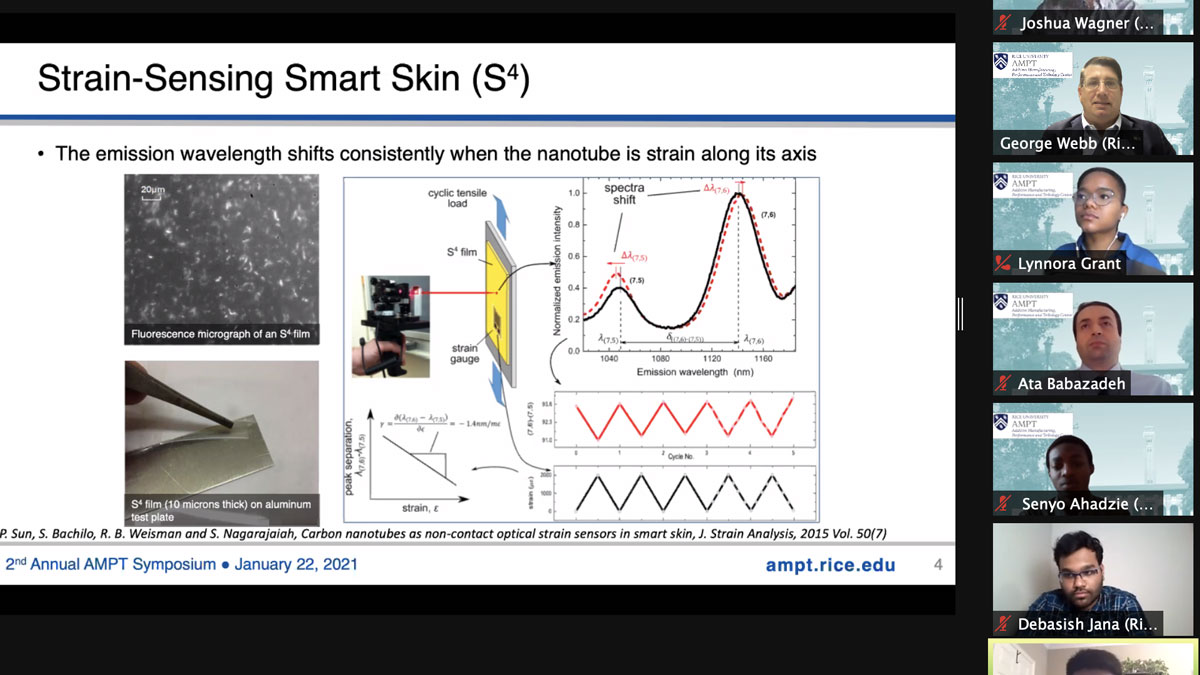More than 100 academics and industry representatives attended the Additive Manufacturing, Performance & Tribology (AMPT) Center’s second annual symposium at Rice University, held virtually on Jan. 22.
“The center combines the work of engineers who wear hard hats and/or lab goggles, and the engineers who work on their laptops all day long. This combination reflects the diversity and strengths of Rice in general and the School of Engineering in particular,” said Luay Nakhleh, the William and Stephanie Sick Dean of the George R. Brown School of Engineering, in his opening remarks.
The AMPT Center was founded in 2019 and brings together three disciplines – additive manufacturing; materials performance and characterization; and tribology and tribomechadynamics – together with the application of data, machine learning and other techniques to solve engineering problems.
Additive manufacturing, known popularly as 3D printing, uses computer-aided-design software or 3D object scanners to assemble material, layer upon layer, in precise geometric shapes. It adds material to create useful objects rather than removing material, as in conventional machining and milling. While 3D printing in plastics is well-established, 3D printing in metals and high-performance materials for industrial components remains a field of advanced research.
“The AMPT Center has grown in every way – more industry participants, more faculty, more students. We’re grateful for our inaugural corporate members, ConocoPhillips and Varel International Energy Services,” said Matthew Brake, one of AMPT’s faculty directors and assistant professor of mechanical engineering (MECH).
Brake conducts research in structural performance and tribology. His work focuses on measuring and analyzing friction in dynamic structures made by joining parts, with applications in the aerospace, defense, and automotive industries.
In his opening remarks, C. Fred Higgs III, the other AMPT faculty director and the John and Ann Doerr Professor of MECH, said:
“At the AMPT Center, we work between the physical and the digital realms, as part of Industry 4.0. We are changing how people work and how products are manufactured.”
Eleven Rice faculty members representing six departments and two schools presented talks in three subject categories.
Materials and Structures:
- Muhammad M. Rahman, research scientist in materials science and nanoengineering (MSNE): “Additive Manufacturing for Multi-Functional Applications”
- Satish Nagarajaiah, professor of civil engineering and of MECH: “3D Printed Schwarzites for Damping Enhancement and Vibration Isolation”
- Jun Lou, professor of MSNE: “Quantitative Nanomechanical Characterization of Low Dimensional Nanomaterials”
- Matthew Brake, MECH: “Digital Twin Modeling of Assemblies to Enable Data Science Applications via Tribomechadynamics”
Surface Sciences:
- Daniel Preston, assistant professor of MECH: “Materials and Coatings for Manipulation of Fluids”
- Geoff Wehmeyer, assistant professor of MECH: “Next-generation Materials and Devices for Improved Thermal Performance”
- Rafael Verduzco, professor of chemical and biomolecular engineering, and of MSNE: “Development of Chemically-Tailored Surfaces Using Bottlebrush Polymers and ToF-SIMS”
Data, Machine Learning, and Industry 4.0:
- Christopher Jermaine, professor of computer science (CS): “One Shot Learning and Learning-to-Learn”
- James Tour, the T. T. and W. F. Chao Professor of Chemistry and of MSNE: “Flash Graphene Scale-up Through Automation and Machine Learning”
- Anshumali Srivastava, assistant professor of CS: “Learning with Exponential Outcomes: Deep Learning with K outputs and only Log(K) Parameters”
- C. Fred Higgs III, MECH: “AM+P+T synthesis: Industry 4.0 Design for Additive Manufacturing in Drilling”
Announced was the AMPT Center’s new Ph.D. Signing Bonus program. The winners of the 2020 AMPT Resiliency Awards were recognized. The symposium concluded with an executive session among industry leaders to identify research priorities and collaboration opportunities for 2021 and beyond. Seven Rice graduate students participated in a competitive “lightning rounds,” giving six-minute presentations of their research.
The symposium organizer was George Webb (B.S. ’88, M.S. ’91), the AMPT Center’s industry liaison.

